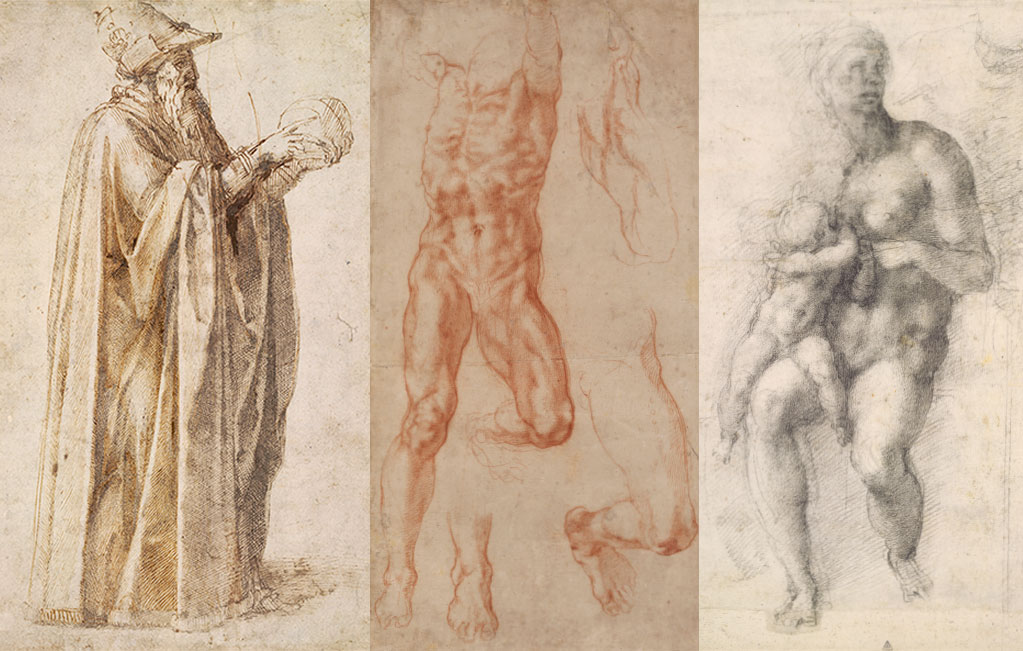Michelangelo Buonarroti: the drawings of the Florentine genius closer than ever
The prestigious British Museum, a world reference in history, archaeology, and art, presents to the public until July 28 one of its most exclusive treasures. It is the collection of drawings and sketches by Michelangelo Buonarroti, an unequivocal symbol of the Italian Renaissance and the creator of the modern artist’s conception.
Drawing as the origin of his art
Sketches and drawings were a fundamental part of Michelangelo’s work, from which everything else emerged and a work of art in themselves. The artist defined them as “the source and body of painting, sculpture, and architecture, as well as the root of all sciences”. Observing the strokes of the man known as Il Divino allows us to understand the mastery and sensitivity of one of the greatest artists of all time.

Left: Michelangelo’s Bruges Madonna, 1501-1504. Marble, 123 cm tall. Church of Our Lady, Bruges.
Right: Sketch of the Virgin with Child, c. 1504-1505; pen and brown ink over a leadpoint sketch, 315 × 277 mm.
The importance of drawing in his life is explained by the training he received from a young age. Although his father planned a life of public service for him, his early skill led him to study in a renowned workshop like that of the Ghirlandaio brothers. Domenico was in charge of tutoring a teenage Michelangelo, instructing him in the Florentine tradition where drawing was the starting point for creating any art.
The most recognized artist of his time
Standing out among his peers from an early age, Michelangelo began to undertake brilliant work for nobles and patrons of his time, such as the Medici family, as well as fulfilling sacred commissions from various popes, adapting to tumultuous and constant political changes. In each commission, drawing was present, allowing him to explore textures and dimensions, movement, and three-dimensional volume on paper before making the leap to the final work in the form of painting, sculpture, or architectural work.

Left: Study for the Medici tombs in the new sacristy, c. 1520-1521. Black chalk, 262 × 187 mm.
Right: Tomb of Giuliano de Medici designed by Michelangelo. New sacristy of the basilica of San Lorenzo, Florence.
However, his unique beauty and skill elevated the category of his drawings to works of art in their own right, making his sketches, plans, portraits, and anatomical details of torsos and limbs considered authentic jewels worthy of admiration and which the author liked to give away to his close ones on multiple occasions.
His ambitious character and constant obsession with perfection led him to compete with himself at a level unreachable for others, constantly learning and improving. He experimented with different materials and drawing techniques, from pen or metal tip in his early stages to red chalk and black chalk during his maturity.

Left: Study of a philosopher holding a round object, 1495-1500. Pen and brown ink (both iron gall), 331 × 214 mm.
Center: Studies for the scene punishment of Haman in the Sistine Chapel, 1512. Red chalk, 404 × 206 mm.
Right: Study of the Holy Family with infant St. John, 1534-1541. Black chalk, 314 × 189 mm. Bequeathed by Richard Payne Knight.
Works of undeniable historical value kept under lock and key
It is hard to imagine how many drawings came from Michelangelo’s hands. The artist dedicated a large part of his surprisingly long life to them: the Florentine genius died just before turning 89, and it is said that he did so with a pencil still in his hand. Despite this, very few drawings have survived to this day: an estimated 600 through inheritances, auctions and more.
The existing specimens are scattered around the world, and the British Museum can boast of holding the most representative collection of this legendary artist. But it is no longer necessary to wait for that moment when the museum displays such delicate works to the public and take a plane to the city of Big Ben to admire those drawings that help to understand the genius and creative process of someone who knew how to unite corporeality and spirituality on paper.
Michelangelo: Drawings is an extraordinary journey beyond space and time, directly to the workshop, mind, and soul of Michelangelo Buonarroti, with 75 sheets from the British Museum’s exclusive collection reproduced like never before and accompanied by the most authoritative voices on the Renaissance genius.

Sarah Vowles, Smirnov Family Curator of Italian and French Drawings and Prints at the British Museum, shows us part of Michelangelo’s collection.
Michelangelo: Drawings – A unique approach to the greatest artist in history
ARTIKA and the British Museum have joined forces to bring the most important collection of Michelangelo’s drawings to the public in an unprecedented opportunity to delve into the artist’s mind through his most intimate works: his drawings.
- Numbered and limited edition of 8,998 copies.
- The work consists of two volumes and a spectacular sculpture-case that pays homage to David, the artist’s most famous sculpture.
- The Art Book features 75 drawings by Michelangelo, 35 of them in full size, in the highest quality reproductions.
- The Study Book includes contributions from leading professionals and experts on Michelangelo’s life and work, complementing each drawing with their valuable knowledge.

